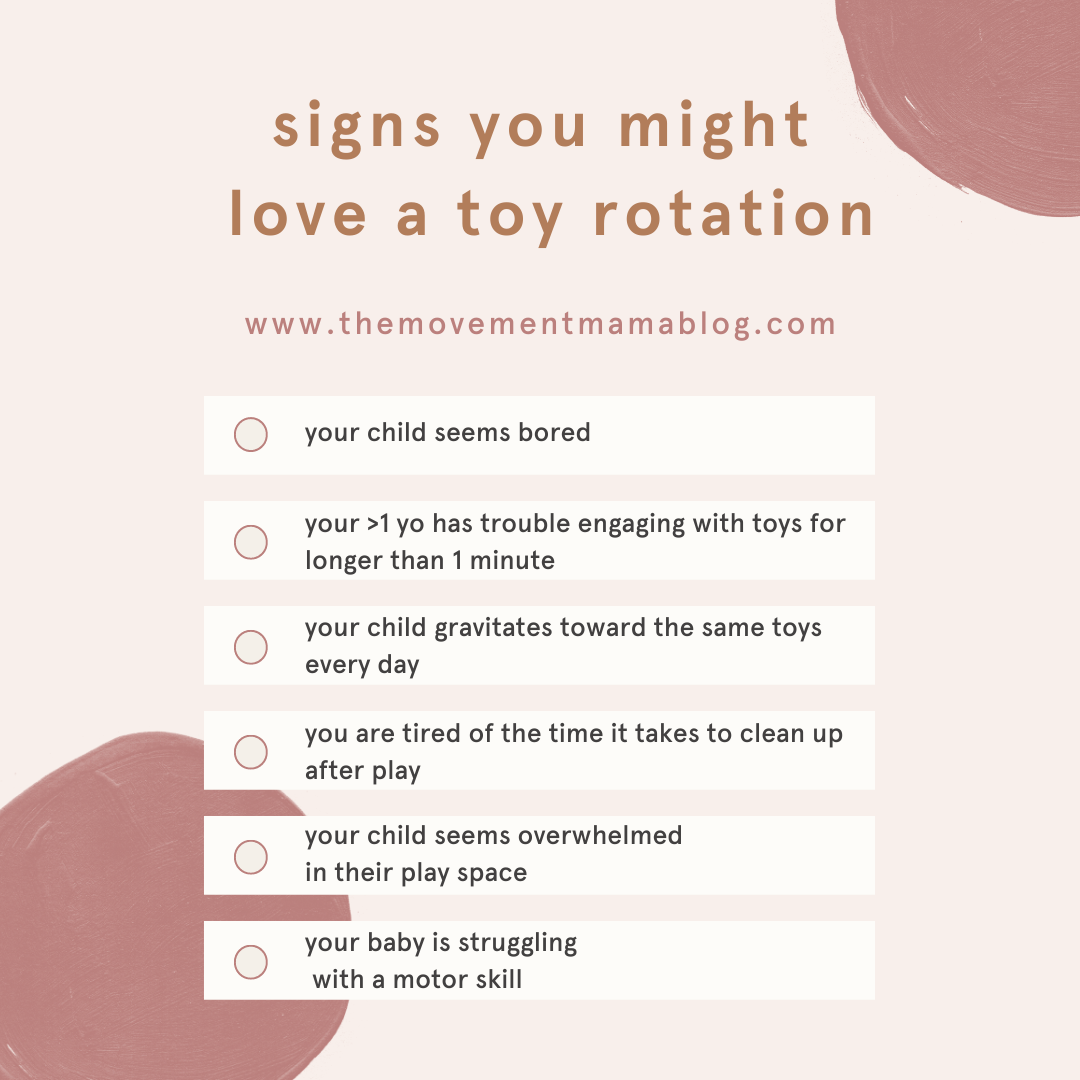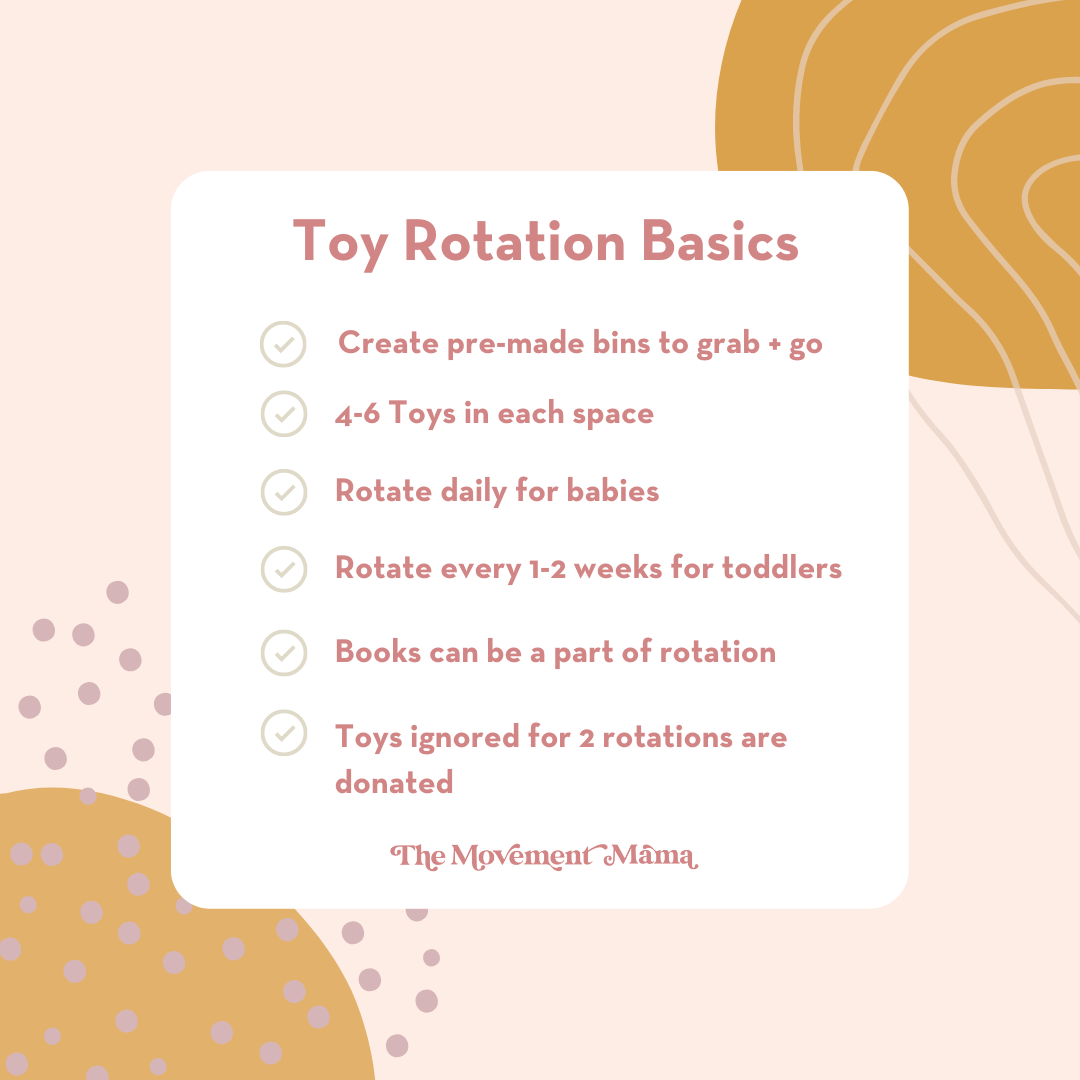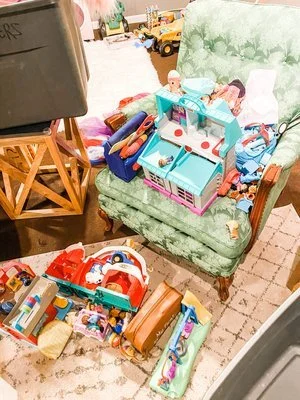Toy Rotation: A Step by Step Guide
Y’ALL. Can I just say that I am THAT person? The one who can’t shut up about things she loves and just wants to share it with the world, including but not limited to random strangers in the grocery line. Toy rotation is one of “those things” that I just cannot stop sharing! It truly has changed the life of play that takes place in our home.
For more resources like this, check out these other Movement Mama posts:
Gifts for the Tummy Time Hater
Creating a Safe Play Space for Babe
Gifts for the Taby: That Awkward Phase Where They're Squishy but Sassy
*This post contains affiliate links that aid in supporting The Movement Mama at no additional cost to you*
For a quick intro, click on each image below to be redirected to some brief highlights over on Instagram! This will help you get a good grasp on where we’re headed and if this article is for you :) I also want to mention, now that my children are older, I’ve realized this specific way of doing toy rotation is best for 3 and under. I am currently revising our system for my 3 and 5 year old and will be creating a new guide for older age groups soon! Regardless of your child’s age, though, I am certain you will find little nuggets in this post that will help you in some way!
+ Now I can’t wait to share with you the step-by-step of my process. I do this once per year and it is SO worth the time that it takes to prep on the front end because I literally can just grab a bin and go now. No effort involved!
Here are some recommended supplies:
+ Clear plastic tubs: Last year I used opaque tubs and it was a lot harder to figure out what was in each bin if I found a random puzzle piece or something that I needed to put away. You can totally use opaque bins if you already have them, just use these handy scannable labels to find exactly what you’re looking for.
+ Boxes for toys to donate
+ A garbage bag for any broken toys or toys with missing parts that likely won’t be recovered
+ Various sizes of storage bags: 2 gallon are great for sensory bin filler storage or larger toys that have small parts that need to be contained. I use quart sized for puzzle pieces or separating out Little People. I also recently discovered these mesh bags that look amazing! I plan to snag some for our bath toys, as apparently we now have so many bath toys that we need to start rotating (bless it). Oh and a change I’m making in 2023 is to put velcro on every puzzle piece so that it doesn’t tumble out everywhere :)
+ Permanent markers
+ Duct tape or a large piece of paper (for labeling the bins)
Here are my Steps for Success:
1. Gather all of your toys in one place: Yes. I mean all of them. All of them that you can find and feel like would be good in rotation. The only things I don’t put in the bins are the large toys (play kitchen, tool bench, Pikler, etc) but I still ROTATE them every few months. I also don’t include our sensory bin filler items or art supplies but I have these organized in a separate space (a post for another time). I find that seeing the magnitude of your toy situation all in one place is quite motivating to get rid of a lot by donating or trashing if they're broken.
2. Pull out anything you want to donate or anything that is broken or missing pieces: Let's break this down into two parts-
+ Donate: Maybe you have multiples of a toy. Maybe you have 500 Little People figurines overtaking your life (ahem, me). Maybe there's a toy your kids just never seem to play with or it doesn't bring you joy when they do. Donate, donate, donate! But before you do, decide on a person or place to donate TO. I made this change the last time around and it was SO much easier to part with toys knowing they were going to a home or nonprofit that needed them far more than we did.
Some ideas I was given are: foster closets, nonprofit childcare centers for children in low socioeconomic areas, asking your church if there are any families identified as being in need, women's shelters, Facebook Buy Nothing groups, etc. Proceed to step 3 and prepare to donate some more.
+ Trash: If a toy is truly broken, trash it. Your husband isn't going to fix it. You're not going to magically have the time to glue it back together. Just trash it. It's not bringing you or your child joy every time you rediscover it's broken. If it's missing parts, hold it out in a specific place to see if you uncover the parts. If after a couple weeks you still haven't found them, trash.
3. Sort into piles based on Category: This is your house and your life. Feel free to come up with categories that work for you! See below for some ideas!
Some of the categories we have used in the past or currently use are:
+ Baby toys: This one is pretty self-explanatory. If you only have a baby you could separate into things like rattles, balls, building toys, musical toys, etc.
+ Large Motor toys: Think basketball hoops, mini trampolines, climbing triangles, tunnels, wobble boards, etc.
+ Fine Motor toys: Things that require more precision with the hands. This piggy bank is an example. So is this Mr. Potato Head. Or this shape sorter.
+ Pretend Play: Our Little People are some of our favorite pretend play items (I'm gonna link my entire Toddler Play idea list here because there are SO many we love. Plus our doctor kits, pretend makeup sets, & farm scenes. I'm in the process of going through all our kitchen stuff, but since the kitchen always stays out in our playroom, I'm going to do separate bags of kitchen utensils and playfood to rotate. But you do you, sis.
+ Dress Up Clothes: As my kids have gotten older, they LOVE to dress up and act out pretend play with their body rather than little figurines or dolls. We’ve found treasure troves secondhand, but we also keep our Halloween costumes in our dress-up clothes rotation each year.
+ Puzzles: I think you get the gist on this one :)
+ Stuffed animals: I have a really strong love-hate relationship with stuffed animals. While they are absolutely adorable, they don't get a whole lot of playtime in our house. I am hoping that as my kids get older they will begin incorporating them into their pretend play because if not, I will have held onto 500 stuffed animals from very well-intentioned family members who have no recollection of the space it requires to store said animals. This is a great place to start your donate pile IMHO, in case you hadn't guessed :)
+ Cars/trucks/trains: This is a rapidly growing pile in our once pink-toy dominated household. I love these pull back cars as a crawling motivator. We also recently got this adorable train set. And I can't wait to take Redding out in the mud to use these.
+ Building things: 100% our most played-with Christmas gift is these Picasso tiles. All family members have enjoyed them so much! Same with our Mega Bloks, and our Lovevery Block Set (this thing is seriously the coolest and has like 10 different ways to play with it).
+ Music toys: These are absolutely not the push and play type of music toys. My sound sensory-overloaded brain cannot handle those. But we do have lots of open-ended musical toys like this sweet Drum set. I've also had my eye on this music set for awhile!
+ Electronic toys: We really try to limit these in our house. Simply because these sorts of toys don't offer the longevity and creativity in play that other toys do. If you want more info on this, check out my Open-Ended vs Closed-Ended toy post here.
Once you have your piles, assess the damage. Is there any specific cateogry that has way more than others? Are your electronic toys far outweighing your more open-ended toys? Are there any duplicates you discovered this go around? Is there anything you're seeing that you're ready to get rid of? Let that donate pile grow! What a blessing it is to bless others.
4. Place Something from each Category into each bin: Here's where you take total creative license. My first year doing this I randomly placed one toy from each category into the bin. And it worked great! This year, I tried to pick "themes" for as many bins as possible.
For example, we have some great Frozen-colored Legos, beautiful princess dresses, blue Picasso tiles, and a Winter-themed sensory bin from Purpose Play KC in one bin. Or in another, I placed our Farm, Melissa & Doug Farm Animal Puzzle, and these hilarious Farm Animal Magnet toys. And I'm also pretty proud of my School-themed bin, with our Little People schoolhouse, school bus, Alphabet puzzle, and primary color Legos Duplos. I give you full permission to not go this route, I've just found that now that Ada June is 3, she is really beginning to expand her pretend play and I think "themed" bins will be great for this. As I begin to do some homeschool, I think it will be nice to find things easily, too.
Keep in mind the 4-6 Toy Guideline: This is the research-backed recommendation that you only keep 4-6 toys PER playspace. This reduces overwhelm and sparks creativity (you can read more about this here) I frequently get asked, "What if my children are different ages?" This is a great question and one you sort of have to decide on for yourself. If you feel like their play is overlapping enough, just do 4-6. If you've got a baby and an older toddler, you can do 4-6 toys each! Totally up to you!
Once you have your bins filled and your toys put away, you're so so close! Congrats, you've nearly made it.
5. Number each Bin & Choose a Time Frame to Rotate: Last year I didn't number my bins and I feel like there were bins that I didn't get to for several rotations. This year, I am numbering each bin. When I put #1 away, I will know it's time for #2, rather than my sleep-deprived Mom brain trying to remember which bin we haven't used in awhile. I've slipped white paper with a big number in each bin. That way I can swap the numbers around mid-year to spice it up! Remember: variety is the key to keeping the Toy Rotation magic alive. Maybe they thought the School bin was coming out next and BOOM! Farm bin is out! Cue the renewed excitement and opportunity for drinking your coffee while it's still hot.
+ Picking a Time Frame: Here's my mindset for this--younger babies have a shorter attention span.
Which means they may get bored with toys sooner.
-For babies 3-12 months, I recommend rotating toys daily. But if you've seen my Toy Rotation for Babies post you know that you don't have to go through the whole process listed above.
-For 12 mos - 3 years, I recommend rotating toys every 1-2 weeks. For us, the sweet spot has been 1 week. But I may try to expand that a bit and see what happens with their play when I do! Remember, all of this is flexible! Try things out and see how it goes :)
-I do also recommend picking a consistent day of the week to always rotate toys. Which days feel the most stressful for you as a parent? When do you feel like you need more space for getting things done around the house? For me, this is Monday mornings. Pick what works for your little family. We are starting a new rhythm this year of Toy Rotation Tuesdays! I’d love for you to join me over @themovementmama to share what you’re putting out in rotation or how it’s going for you :)
6. Watch the Magic Unfold as your Child discovers they have "new" toys each week: My entire family thought I was crazy...until my Mom was visiting on a Toy Rotation day. She saw the magic come alive and now she's that person in the grocery line telling everyone about it! I truly hope this brings your family as much joy and peace as it has ours. My little ones love dragging everything out of the bin on the morning of and I love sitting on the couch drinking my coffee in peace. At nap time I then separate the toys for each playspace (living room, basement, bedroom). I allow them to shift toys around if they want but usually they keep them in the room they go in. I also don't really allow trade-ins. This is a rule I set from the start to keep things less complicated.
7. Donate Gently Used items: Do. Not. Lose. Focus! Remember the sweet families and babies you will bless with your toys! Remember the gigantic, overwhelming pile you started with. Don't let your kids pull from the donate pile, either. It's best they don't even see it (I'm a mean Mom, I know). As they get older it's a great opportunity to talk about giving to others but trust me, when they're 3 and under, they don't understand. And they will be upset. Tell them after the fact and let them share in the joy of being able to give to those who need it more than them! But trust me on this one. Their little puppy dog eyes will pull everything back out faster than you can say "toy rotation" if you tell them there's a donate pile (speaking from experience, my friends).
I also want to give the disclaimer that this may not be the situation for everyone. We have been immensely blessed by family gifting toys and hand-me-downs from friends. Our little Ada June was the first grandchild on both sides so you can imagine that scenario. But I don't want to make light of how overwhelmingly privileged we are in this. We had a pile of toys taller than my head. And to whom much is given, much is expected. I'm so grateful to use it as an opportunity to give. But please know that I am aware this is not the situation with every family. And I don't take any of it for granted for even a second.
8. Keep a Donate Box & Missing Pieces Box for future use. Each toy rotation, if I found missing pieces later and couldn't remember which bin the toy was in, I would throw them in a missing pieces box and try to put them together again the next round of rotations. The clear bins + number system should help alleviate some of this.
FAQ's:
Q. What do you do with seasonal stuff?! I put seasonal items in my seasonal decor boxes (this includes seasonal books, sensory bins, etc). It makes the most sense to me that way and when I pull out the decor, we all have a fun little surprise!
Q. Do you count books as a "toy"? I don't count books as a toy. This past year I divided up the books into each toy rotation with 4-6 per playspace, as well. Now that Ada June has a big bookcase in her room, I haven't done that. I'm trying to figure out a system for this and am considering using dot stickers on the edges of the books and pulling out certain colors each week. TBD! As we near homeschool, I will also begin pulling books on certain topics. I recently reorganized all our books into categories and it’s been so nice to be able to easily pull things the kids ask about or we are discussing that week!
Q. Where do you store the toys? We store ours in a basement storage room. But I realize not everyone has this option. Some other ideas: under the bed storage or ottoman storage.
Q. What do you do with the big items? I rotate large items into/out of rotation and/or between rooms. For example, we have a foam play couch. If the kids aren't playing with it as much, I'll move it from the basement to their bedroom or the living room. Our play kitchen also typically lives in the basement but is currently in our living room to jazz things up a bit. We have the space to put these items away for a time too! Outside is also a great option for big items in the summer and vice-versa, move riding toys inside if you have the space!
Q. What if my child has a favorite toy they always want? This has to be your judgment! If it's something that is a comfort item, keep it out always. If it's something they just obsess over playing with, I recommend putting it in toy rotation to allow their play to expand.



